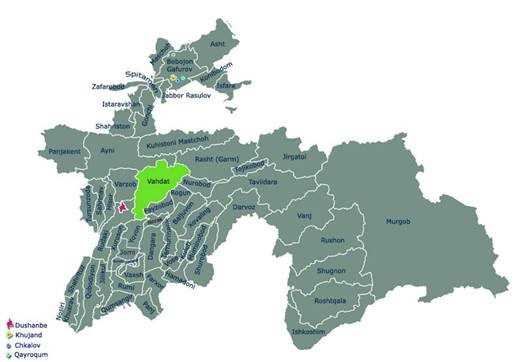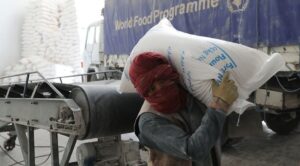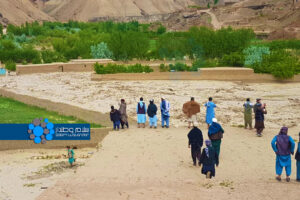MONITORING (SW) – Following the political upheavals in Afghanistan in recent years, a wave of frightened people sought refuge in neighboring countries, including Tajikistan, as a gateway to safer countries.
According to UNHCR, on June 2023, a total of 7,900 refugees moved to Tajikistan. This wave of migration in 2021 has only exacerbated an already existing community of Afghans who have been living in Tajikistan for years, patiently awaiting their chance to start a new life in a more stable environment.

According to Abdul Musavvir Bahaduri, the Chairman of the Aryana Assembly/Committee of Afghan Migrants in the Republic of Tajikistan, approximately six thousand Afghan nationals are residing in the cities of Dushanbe, Khujand, Sugd, and Vahdat in Tajikistan. Among them, 90% of Afghan migrants have made their home in the city of Vahdat.
However, Afghan migrants face certain restrictions, such as curfew and choices of residence , for example they can not live within the big city. According to the Government of the Republic of Tajikistan Resolution No. 325 of 2000, refugees and asylum seekers are not allowed to live in big cities or in the border districts of the country. Now, Afghan refugees live in various districts across Tajikistan including in Vahdat, Rudaki, Hissor, Shakhrinav, Bohtar, and Jabbor Rasulov districts. Abdul Musavvir Bahaduri says that there are several issues that Afghan refugees face, such as economic hardship, lack of jobs, low wages, insufficient employment opportunities that do not provide enough to sustain a family’s livelihood. Even prompting many young Tajik citizens to migrate to other countries for work, the overall cost of living being very high, the rent prices being exorbitant, and also a lack of attention and cooperation from international organizations and charities.
Although foreigners or stateless persons above 18 have the right to apply for Tajik citizenship as per Article 14 of the Law on Citizenship of the Republic of Tajikistan, no Afghan nationals have received passports since 1998. This leaves many Afghans living in uncertainty, prompting them to seek sponsors (Community Sponsors or Groups of Five, which could provide financial support to refugees to open applications and travel to Canada while they adopt the environment abroad). However, about 70% of migrants in Tajikistan are unable to progress and are effectively trapped in the country due to lack of sponsors.
Najia Eslami, a young Afghan girl in her early 20s, describes her life in Tajikistan for 16 years. She came with her family in 2016 to Tajikistan and settled with local people, studying and working. She says, “I adopted the Tajik society to the extent that I do not want to go back to my home country.”
She highlights that Afghans can practice their own culture easily in Tajikistan due to the huge similarity between Tajik and Afghan culture. She never experienced discrimination from local people or the government, and she says that local people welcome and respect Afghans in this country.
However, like other Afghan refugees, she does not want to remain in Tajikistan forever. Despite earning a degree and considering a career as a history teacher, she does not want to work in Tajikistan due to the low salary and hard work.
Though she likes living in Tajikistan due to the low income and uncertain future, she says, “Everyone wants to get out of Tajikistan as soon as they find a sponsor in western countries.”
Ahmad is a 45-year-old Afghan man who has been living in Vahdat, Tajikistan, for 2 years. He also chose Tajikistan due to the similarity of language, tradition, and safety. He is living with his family in Tajikistan, and he is also working as a construction worker based on his experience. The job is hard, but the wage is not enough, especially for those who are the providers of the whole family.
He says, “The main problem for migrants in Tajikistan is the uncertainty of their future. They work in construction and as taxi drivers for very low wages and struggle to pay taxes. If they cannot afford it, continuing their education becomes impossible. It can be said that 95% of migrants have been left out of higher education.” Therofer is waiting for an opportunity to leave Tajikistan as soon as he finds one.
Krishma is a 26-year-old Afghan girl. She and her family recently got to Canada through a sponsorship program after 13 years of living in Khujand, Tajikistan. Despite the obstacles, Krishma managed to complete her education, becoming the only sibling to do so while her younger siblings were still in secondary school and her older sibling had to give up on their education to financially support the family at a young age in Tajikistan.
Reflecting on their journey, Krishma shares, “We knew that we would not live in Tajikistan forever, and also returning to Afghanistan after so many years was not a good option. Therefore, we waited patiently even though we were afraid of any rejection from the Canadian government.”
The influx of Afghan refugees seeking safety and stability in Tajikistan has brought attention to the challenges and limitations faced by migrants in the country. Despite adopting the culture and feeling welcomed by the local population, many Afghan refugees are unable to progress due to restrictions on citizenship, lack of employment opportunities, and low wages. The uncertainty of their future and the desire to seek better opportunities in Western countries drive many migrants to find sponsors for relocation. The stories of individuals like Najia, Ahmad, and Krishma highlight the struggles and resilience of Afghan refugees in Tajikistan, emphasizing the need for continued support and assistance for those seeking a better future outside the confines of their temporary refuge.






